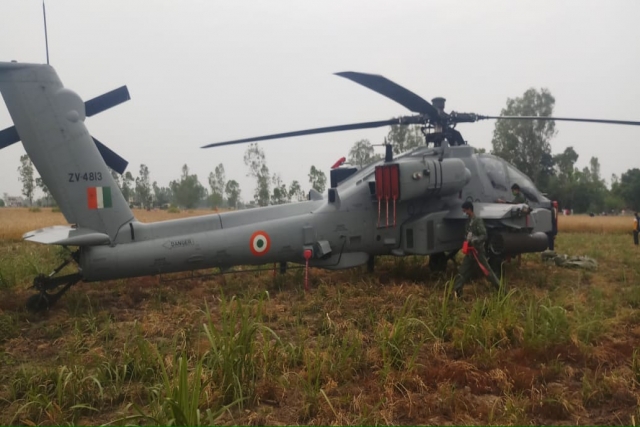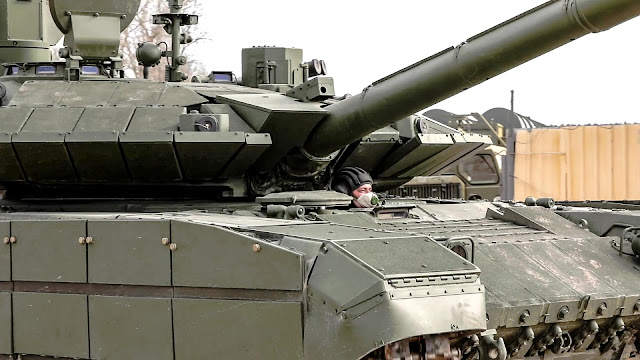Survivability in battle is priority No. 1. Transportability by aircraft? It’s been demoted to a subitem under priority No. 7. designs are due in 2023, physical prototypes in 2025, and operational vehicles by 2028.
The Mission Enabling Technologies Demonstrator manned vehicle can operate two unmanned platforms to make contact with the enemy before soldiers do, while achieving overmatch against future operating environment threats. The Army’s vision includes three robotic vehicle variants—light, medium and large, but service officials have decided for now to cancel the acquisition of a medium variant. U.S. Army photo by Jerome Aliotta/Released
WASHINGTON: Last night, with face-to-face meetings shut down by the COVID-19 coronavirus, the Army posted
14 pages of in-depth answers to industry’s questions about the rebooted Optionally Manned Fighting Vehicle program.
Just in case anyone didn’t understand just how thoroughly the Army has changed course, the document released yesterday spells it out: “No requirements from the
first RFP [Request For Proposals] remain valid. This is a new RFP.”
The Army cancelled that first attempt at OMFV back in January when no bidder could meet its ambitious schedule and technical requirements. OMFV is meant to replace the Reagan-era M2 Bradley troop carrier with a “transformational” war machine boasting extensive automation, tactical networking, and other cutting-edge technologies.
A US Army M2 Bradley and Hungarian BTR-80s exercise in Lithuania. The BTR-80, like most European troop carriers, is much more lightly armed and armored than the Bradley.
Two critical details of the “programmatic narrative” stand out: the emphasis on survivability over transportability, and the more realistic demands on industry for both timeline and technology. The revised vehicle is now even more clearly focused on combatting the Russian threat in Eastern Europe.
For the first time, the Army put its nine desired “characteristics” for the OMFV in rank order.
Survivability beats transportability
For the first time, the Army unequivocally makes survivability the top priority, ahead of air transportability.
Now, that’s survivability against enemy Infantry Fighting Vehicles like the Russian BMP,-3 armed with anti-tank missiles and mid-calibre weapons, not against main battle tanks with 125 mm high-velocity cannon: “The OMFV must protect its crew and infantry from enemy IFVs,” the narrative states. But survivability is nevertheless central to the Bradley replacement’s mission statement (emphasis ours): “The OMFV will serve as the Army’s Infantry Fighting Vehicle (IFV) tasked to maneuver through the enemy’s disruption zone and deliver Soldiers to their dismount point unharmed.”
The new document even puts survivability (priority No. 1) slightly ahead of ground mobility (priority No. 2). While weight isn’t as big a factor on the ground as in the air, heavily armored vehicles over 50 tons – like the M1 Abrams main battle tank – can’t safely cross most bridges in Eastern Europe.
By contrast, the Army’s original Request For Proposals required two OMFVs to fit on a single Air Force C-17 jet transport. That meant they could be no heavier than a late-model Bradley, even though they were supposed to be much better armored.
The new document makes clear that, in the vast majority of both historical and projected conflicts, heavy armored units rarely move by plane. “The Army anticipates that Armored Brigade Combat Teams (ABCT) will continue to deploy primarily via water and rail, but must maintain the ability to transport via air as an option for commanders,” the programmatic narrative says. “The C-5 and C-17 will be the primary aircraft used to transport the OMFV.”
Two crucial pieces of context here. First, the C-5 is a much larger Air Force transport than the C-17, able to carry twice the load. Second, even though the C-17 is still an option, there’s nothing about fitting more than one OMFV aboard.
A single C-17 (right column) can carry 1 M1 Abrams main battle tank, two M2 Bradley infantry fighting vehicles, or three partially disassembled AH-64 Apache helicopters. A C-5 (left column) can carry twice as much. SOURCE: Lockheed Martin
Yes, the Army is giving up some strategic flexibility here. The service has struggled for eight decades to square the circle of an armored vehicle heavy enough to survive and light enough to transport by air. The resulting compromises ranged from partial successes to total failures: the little-used M22 Locust of World War II, the problematic M41 Walker Bulldog of the 1950s, the breakdown-prone M551 Sheridan used in Vietnam and Panama, the cancelled Future Combat System of the 2000s, and the ongoing Mobile Protected Firepower program.
But while the Air Force can fly a few tanks almost anywhere on short notice — which could be decisive against a lightly armed adversary — there just aren’t enough planes to deploy and supply multiple armored brigades, which is what you’d need against a foe like Russia.
Fortunately, while lightly armed adversaries could and do pop up unexpectedly around the world, we know exactly where Russia is and what countries its armored legions can reach. That’s why the US is prepositioning warehouses full of armored vehicles and other equipment in Europe.
We also know where China could strike, but the Western Pacific, with its scattered, rugged islands, is poor terrain for tanks. While the Army and Marines plan to deploy missile launchers on Pacific Islands, any Chinese landing force sent to dig them out would have to come by ship or plane, limiting the weapons it could bring.
If you know where the war you’re worried about will be, the best time to get there is before the shooting starts. By choosing to optimize the OMFV for Eastern Europe, rather than make it a jack-of-all trades for crises worldwide, the Army makes the program’s problems much more solvable.
More time, more money, more leeway for bidders
The tentative schedule released yesterday (above) starts with an extensive period of back-and-forth between industry and the Army, already underway, about what the new vehicle should look like.
- A formal Request For Proposals based on these discussions won’t come out until April 2021.
- In October 2021, the Army will kick off the first round of competition, picking up to five of those proposals it will pay industry to develop into “initial digital designs.” The Army will then evaluate those virtual vehicles in computer models and simulations.
- In April 2023, the Army will narrow the field further, to at most three competitors, which will get government funding to refine their designs and build actual working prototypes by July 2025.
- The Army will test those prototypes through 2026 and pick one winner in January 2027. The winning vehicle will Low-Rate Initial Production (LRIP) later that year, and a full battalion of OMFVs should be operational by September 2028.
By contrast, the original Request For Proposals, released in March 2019, demanded each bidder build a working vehicle at its own expense as and deliver this “bid sample” by Oct. 1st last year. Most potential manufacturers didn’t even try, and only one competitor, General Dynamics, managed to meet the deadline. Then the Army disqualified GD’s vehicle anyway for not meeting the (arguably impossible) requirement to combine heavy armor with air transportability.
This time around, “the Army is not requiring any bid samples prior to contract award,” yesterday’s release makes clear. “The Army is still drafting the M&S [Modeling & Simulation] test plan which may require vendors to build early surrogate platforms” (emphasis ours), but any “surrogate” will be only “a low-level mockup (e.g., digital, wood, etc.),” not anything nearly as expensive as an actual drivable vehicle.
By contrast, the original Request For Proposals, released in March 2019, demanded each bidder build a working vehicle at its own expense as and deliver this “bid sample” by Oct. 1st last year. Most potential manufacturers didn’t even try, and only one competitor, General Dynamics, managed to meet the deadline. Then the Army disqualified GD’s vehicle anyway for not meeting the (arguably impossible) requirement to combine heavy armor with air transportability.
This time around, “the Army is not requiring any bid samples prior to contract award,” yesterday’s release makes clear. “The Army is still drafting the M&S [Modeling & Simulation] test plan which may require vendors to build early surrogate platforms” (emphasis ours), but any “surrogate” will be only “a low-level mockup (e.g., digital, wood, etc.),” not anything nearly as expensive as an actual drivable vehicle.
As with air transportability, the Army is giving up something it wanted: time. While the original plan would have put operational OMFVs in a combat unit by 2026, the new schedule adds two more years. Fielding enough to fight the Russians in Eastern Europe will take even longer.
There is a strategic risk to not having the new vehicles in time. But there is an equal danger of taking on too much too fast — and failing. Then you might not get any new vehicles at all – which is what happened with the Army’s last two attempts to replace the Bradley, the Future Combat System and the Ground Combat Vehicle. The service can’t afford another failure, which means realism has to trump ambition.
That’s why yesterday’s release also doubles down on a key feature of the rebooted OMFV approach first outlined in February: Instead of requiring bidders to meet rigid technical requirements, which may or may not be feasible, the Army is laying out broad “characteristics” and asking industry how best to achieve them. (Those characteristics were first spelled out in February, but they weren’t explicitly put in order by priority until now). Only after years of dialogue, digital design work, and simulations show what’s really feasible does the Army plan to lock down technical requirements.
“The magic here is keeping broad characteristics and slowly refining them over time,” Army Futures Command’s director for armor modernization, Brig. Gen. Richard Ross Coffman, told me back in February. “We won’t lock requirements until we absolutely have to.”





























